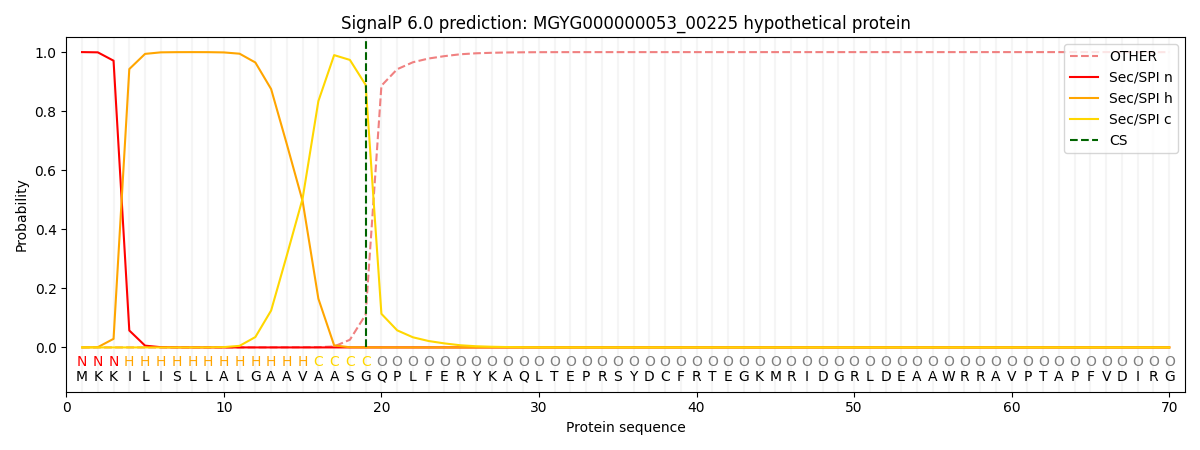You are browsing environment: HUMAN GUT
CAZyme Information: MGYG000000053_00225
You are here: Home > Sequence: MGYG000000053_00225
Basic Information |
Genomic context |
Full Sequence |
Enzyme annotations |
CAZy signature domains |
CDD domains |
CAZyme hits |
PDB hits |
Swiss-Prot hits |
SignalP and Lipop annotations |
TMHMM annotations
Basic Information help
| Species | Alistipes sp002358415 | |||||||||||
|---|---|---|---|---|---|---|---|---|---|---|---|---|
| Lineage | Bacteria; Bacteroidota; Bacteroidia; Bacteroidales; Rikenellaceae; Alistipes; Alistipes sp002358415 | |||||||||||
| CAZyme ID | MGYG000000053_00225 | |||||||||||
| CAZy Family | CBM9 | |||||||||||
| CAZyme Description | hypothetical protein | |||||||||||
| CAZyme Property |
|
|||||||||||
| Genome Property |
|
|||||||||||
| Gene Location | Start: 255530; End: 257575 Strand: + | |||||||||||
CAZyme Signature Domains help
| Family | Start | End | Evalue | family coverage |
|---|---|---|---|---|
| CBM9 | 47 | 249 | 9.6e-41 | 0.9835164835164835 |
CDD Domains download full data without filtering help
| Cdd ID | Domain | E-Value | qStart | qEnd | sStart | sEnd | Domain Description |
|---|---|---|---|---|---|---|---|
| cd09620 | CBM9_like_3 | 5.67e-73 | 47 | 248 | 1 | 200 | DOMON-like type 9 carbohydrate binding module. Family 9 carbohydrate-binding modules (CBM9) play a role in the microbial degradation of cellulose and hemicellulose (materials found in plants). The domain has previously been called cellulose-binding domain. The polysaccharide binding sites of CBMs with available 3D structure have been found to be either flat surfaces with interactions formed by predominantly aromatic residues (tryptophan and tyrosine), or extended shallow grooves. CBM9 domains found in this uncharacterized heterogeneous subfamily may co-occur with various other domains. |
| cd09618 | CBM9_like_2 | 3.33e-29 | 35 | 218 | 1 | 170 | DOMON-like type 9 carbohydrate binding module. Family 9 carbohydrate-binding modules (CBM9) play a role in the microbial degradation of cellulose and hemicellulose (materials found in plants). The domain has previously been called cellulose-binding domain. The polysaccharide binding sites of CBMs with available 3D structure have been found to be either flat surfaces with interactions formed by predominantly aromatic residues (tryptophan and tyrosine), or extended shallow grooves. CBM9 domains found in this uncharacterized subfamily are typically found at the N-terminus of longer proteins that lack additional annotation with domain footprints. |
| COG1649 | YddW | 1.37e-10 | 401 | 629 | 125 | 339 | Uncharacterized lipoprotein YddW, UPF0748 family [Function unknown]. |
| pfam06452 | CBM9_1 | 6.06e-07 | 47 | 199 | 1 | 133 | Carbohydrate family 9 binding domain-like. CBM9_1 is a C-terminal domain on bacterial xylanase proteins, and it is tandemly repeated in a number of family-members. The CBM9 module binds to amorphous and crystalline cellulose and a range of soluble di- and monosaccharides as well as to cello- and xylo- oligomers of different degrees of polymerization. Comparison of the glucose and cellobiose complexes during crystallisation reveals surprising differences in binding of these two substrates by CBM9-2. Cellobiose was found to bind in a distinct orientation from glucose, while still maintaining optimal stacking and electrostatic interactions with the reducing end sugar. |
| pfam02638 | GHL10 | 6.77e-07 | 391 | 634 | 68 | 299 | Glycosyl hydrolase-like 10. This is family of bacterial glycosyl-hydrolase-like proteins falling into the family GHL10 as described above,. |
CAZyme Hits help
| Hit ID | E-Value | Query Start | Query End | Hit Start | Hit End |
|---|---|---|---|---|---|
| QCQ41457.1 | 0.0 | 14 | 676 | 22 | 684 |
| QTO24490.1 | 0.0 | 14 | 676 | 21 | 683 |
| QRP90424.1 | 0.0 | 14 | 676 | 22 | 684 |
| QCQ37007.1 | 0.0 | 14 | 676 | 21 | 683 |
| AKA51642.1 | 0.0 | 14 | 676 | 22 | 684 |
Swiss-Prot Hits help
SignalP and Lipop Annotations help
This protein is predicted as SP

| Other | SP_Sec_SPI | LIPO_Sec_SPII | TAT_Tat_SPI | TATLIP_Sec_SPII | PILIN_Sec_SPIII |
|---|---|---|---|---|---|
| 0.000772 | 0.998326 | 0.000245 | 0.000232 | 0.000207 | 0.000196 |
